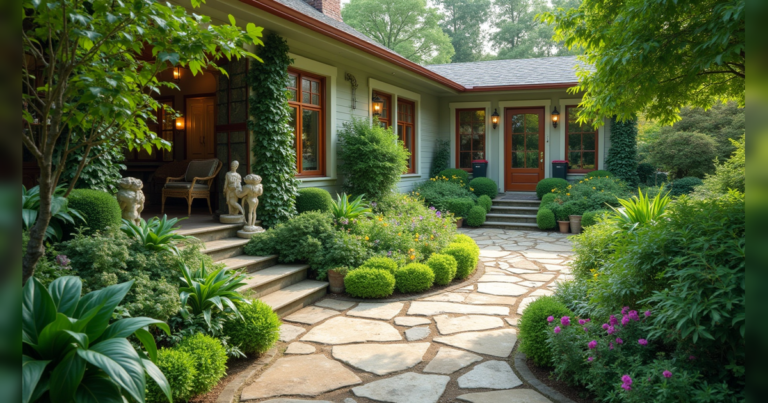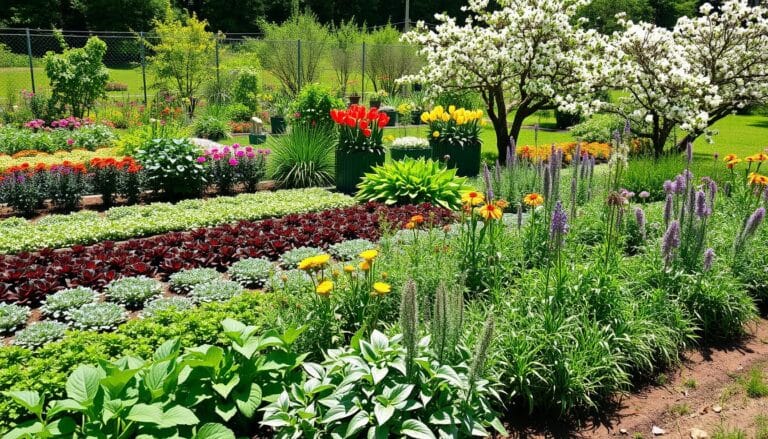Vibrant Green Landscape : A Haven of Peace

As I step outside, I see the beauty of native wildflowers and drought-resistant grasses. There’s also a rain garden that collects and filters stormwater. This isn’t just any ordinary landscape. It shows the power of green landscaping, changing my backyard’s look and deepening my connection with nature.
Green landscaping, or eco-landscaping, focuses on sustainability and caring for the environment. It’s a new way of designing and maintaining outdoor spaces. We’ll look at its basics, its benefits, and what makes a green space truly special.
Table of Contents
Understanding the Basics of Green Landscaping
Adopting eco-friendly landscaping changes how we design and care for our outdoor areas. It focuses on protecting the soil, saving resources, and supporting biodiversity. By grasping these basics, homeowners can greatly benefit their property and the environment.
Core Principles of Eco-Friendly Landscaping
- Soil protection: Preventing erosion and maintaining the health of the soil to support thriving plant life.
- Resource conservation: Efficient management of water, energy, and existing natural materials to minimize waste.
- Biodiversity promotion: Creating habitats and environments that support local wildlife and foster a balanced ecosystem.
Benefits for Environment and Homeowners
Choosing sustainable design in landscaping offers many perks. It boosts climate resilience, supports wildlife, and provides natural pest control and pollination. Plus, it can save energy and increase your home’s value.
Key Components of Sustainable Design
Sustainable landscaping combines several key elements. It uses native plants, manages water wisely, avoids harmful chemicals, and chooses eco-friendly materials. It also includes solar power and composting. These practices help create beautiful, eco-friendly outdoor spaces.
“Sustainable landscaping is not just about creating beautiful outdoor spaces; it’s about respecting the delicate balance of our local ecosystems and minimizing our environmental impact.”
The Essential Elements of a Green Landscape
To make a sustainable, eco-friendly landscape, you need to think about a few key things. You should use native plants, save water, and avoid harmful chemicals. Also, choose materials and features that are good for the planet.
Choosing the right native plants is the first step. These plants are perfect for your area’s soil and weather. They need little care and help local animals by providing food and homes.
Water is also very important. Use water conservation methods like drip irrigation. This helps save water and keeps your garden looking great. Also, using compost and permeable surfaces helps with water management.
It’s important to use safe pest control and eco-friendly materials for your landscape. This makes your garden safe for your family and local animals. Adding solar-powered lights and water features also helps save energy and reduce harm to the environment.
When you put all these elements together, you get a permaculture design. This design is both beautiful and sustainable. It’s good for you and the planet.
“A well-designed green landscape is not only visually stunning but also a testament to our commitment to environmental stewardship.” – Jane Doe, Landscape Architect
Native Plants and Biodiversity in Sustainable Gardens
Using native plants is key to eco-friendly gardens. These plants fit well with local weather and soil. They help biodiversity and keep the environment healthy.
By picking plants that match your area, your garden will need less water and care. It will also attract many different animals.
Selecting Region-Appropriate Plants
Choosing the right native plants is crucial for a green garden. These plants are made for your area’s weather and soil. They need less care and water than other plants.
This choice helps your garden use less water and chemicals. It also supports local wildlife.
Creating Wildlife-Friendly Habitats
Native plants are great for local animals. They offer food and shelter for birds, insects, and more. This makes your garden look better and helps the ecosystem.
When native plants and animals work together, they create a healthy environment. This balance is good for everyone.
Benefits of Local Species Integration
Native plants bring many benefits to your garden. They fight pests and diseases without harmful chemicals. They also need less water and food.
By using local plants, your garden becomes stronger and more eco-friendly. It helps protect biodiversity and fights climate change.
| Benefit | Statistic |
|---|---|
| Carbon Sequestration | A single mature tree can absorb approximately 48 pounds (about 21.8 kilograms) of carbon dioxide per year, sequestering about 1 ton of carbon dioxide over its lifetime (USDA Treefacts, 2024). |
| Biodiversity Conservation | Native plants could provide one-third of the mitigation required to stabilize global warming by 2030 (Griscom et al., 2017). |
| Ecosystem Restoration | Sustainable efforts could potentially avoid a projected $14 trillion loss in natural resources due to biodiversity loss (Mrema, 2021). |
“The restoration of native habitats and ecosystems is highlighted as a measure to protect and enhance biodiversity.”
– Convention on Biological Diversity, 2022
Water Conservation Techniques and Management
Water conservation is key in sustainable landscaping. Homeowners and gardeners can use many methods to cut down water use. Xeriscaping is one way, which uses plants that need little water. This helps reduce the need for water on lawns and in gardens.
Rain barrels are another good idea. They collect rainwater for plants. This cuts down on the need for tap water. Rain gardens also help by catching and filtering stormwater, helping the ground water.
Managing your irrigation system is also important. Using systems that water plants at their roots can save water. Also, adjusting watering based on weather and soil helps avoid too much water.
| Water Conservation Technique | Benefits |
|---|---|
| Xeriscaping | Reduced water usage, low-maintenance landscaping |
| Rain Barrels | Harvesting rainwater for gardening, reducing reliance on municipal water |
| Rain Gardens | Capturing and filtering stormwater runoff, promoting groundwater recharge |
| Sub-surface Irrigation | Minimizing evaporation and water waste, delivering water directly to plant roots |
| Irrigation Scheduling | Delivering the right amount of water at the right time, reducing overwatering and runoff |
Using these water-saving methods and a good irrigation system can greatly reduce water use. This helps keep your landscape healthy and sustainable.
Sustainable Materials and Resource Management
The landscape architecture world is moving towards more sustainable practices. This includes using eco-friendly materials and managing resources wisely. Recent surveys showed that the community eagerly awaited new resources from ASLA. These resources aim to cut down greenhouse gas emissions and boost carbon sequestration by 2040.
They also aim to offer economic benefits like ecosystem services and green jobs. This will help the environment and create jobs in the green sector.
Recycled and Eco-Friendly Materials
Materials like concrete, metal, and locally sourced items are key in sustainable gardens. They help reduce environmental harm and improve soil health. Options include wood, metal, recycled materials, paving, compost, and natural stones.
Energy-Efficient Landscaping Solutions
Sustainable landscaping cuts pollution and protects water and soil. It also lowers emissions and manages waste efficiently. These practices can increase property value and save money in the long run.
Using eco-friendly tools and water-saving systems like drip irrigation helps. Rainwater harvesting is also beneficial for an eco-friendly garden.
Waste Reduction Strategies
Landscaping can manage waste through composting and using organic fertilizers. Permeable pavers help reduce runoff and recharge groundwater. Organic compost improves soil and reduces waste.
Sustainable mulch can be made from leaves, grass clippings, and wood chips. This approach helps create green spaces that are good for both homes and the planet.
“The ASLA Climate Action Plan focuses on addressing climate injustices, empowering communities, increasing equitable distribution of climate investments, and restoring ecosystems while protecting biodiversity.”
Natural Pest Control and Soil Health
A lush, vibrant lawn is more than just mowing and watering. It needs a holistic approach for health and pest control. Eco-friendly landscaping practices help create a thriving garden that’s good for your home and the environment.
Encouraging beneficial insects is key to natural pest control. Ladybugs, lacewings, and praying mantises eat pests like aphids and grubs. This reduces the need for harmful chemicals, keeping your garden’s ecosystem balanced.
Soil health is also crucial for a resilient lawn. Composting and mulching feed your soil, giving it nutrients and helping it hold moisture. Using organic fertilizers keeps your lawn green and protects soil life.
These natural practices offer many benefits. You’ll have a beautiful lawn and help local biodiversity. Plus, you’ll use fewer harmful chemicals. It’s good for you and the planet.
“Healthy soil is the foundation of a thriving, pest-resistant lawn. By focusing on natural solutions, we can create landscapes that are not only beautiful, but also sustainable and beneficial for the ecosystem.”
Keeping your lawn green doesn’t harm the planet. With the right knowledge and approach, you can have a soil protection haven. It will look great and be good for the environment.

Energy Efficiency Through Strategic Landscaping
Your landscape can greatly help make your home more energy-efficient. By placing trees wisely, using solar power, and enhancing natural light, you can cut down on energy use and carbon emissions.
Tree Placement for Temperature Control
Planting trees on the north and west sides of your home can offer shade in summer. This can lower your air conditioning costs by up to 25%. In winter, deciduous trees let sunlight in, helping to keep your home warm.
Solar-Powered Landscape Features
Use the sun’s power in your landscape with solar lights, irrigation, and water features. These can lessen your need for electricity from the grid. Look for local rebates to make these green upgrades more affordable.
Natural Lighting Solutions
Using natural light in your outdoor areas can save energy. Ground covers, trellises, and clear patio materials can all help. They let sunlight in, reducing the need for artificial lights.
By adding these energy efficiency elements to your landscape, you create a beautiful, sustainable space. It not only looks great but also saves money and helps the environment in the long run.
Cost Considerations and Long-Term Benefits
Sustainable gardening and eco-friendly landscaping might cost a bit more at first. But, the long-term gains make it a smart choice for many.
Sustainable gardening helps cut down on water and energy bills. Using drought-resistant plants means less watering, saving you money. Also, smart eco-friendly landscaping can make your home more energy-efficient. This can lower your bills for cooling and heating.
- Professional landscaping can increase a home’s price tag by 15 to 20 percent at the time of resale.
- Properties adjacent to naturalistic parks and recreational greenways often see a price increase of up to 20 percent.
- Well-maintained landscaping enhances property values by increasing curb appeal, perceived value, and neighborhood appeal.
The long-term benefits of sustainable landscaping are huge. It can boost your property’s value, sell faster, and make you and your neighbors happier. It also helps the environment by reducing soil erosion and improving air quality.

Even though it might cost a bit more upfront, the benefits of sustainable gardening and eco-friendly landscaping are worth it. It’s a wise choice for homeowners and property owners looking to the future.
Conclusion
Green landscaping is a way to make outdoor spaces better for the environment. It uses native plants, saves water, and picks materials that are good for the planet. This approach helps you enjoy your garden while also helping the environment.
Even though it might cost more at first, green landscaping saves resources and boosts biodiversity. It also makes your home more energy-efficient. This makes it a smart choice for your property and the planet.
Green landscaping has many benefits, like saving money on upkeep and building community spirit. Using plants that don’t need much water and efficient irrigation systems helps. It also uses materials that are good for the planet.
This way, your garden not only looks great but also helps the planet. With the right care, your green space can be a model for others. It shows the way to a greener future.
Choosing green landscaping is a personal and community choice. It has a big impact on the environment and your life. By starting a sustainable garden, you invest in your local ecosystem. You also enjoy the many benefits of living in harmony with nature.
FAQ
What is green landscaping?
What are the core principles of eco-friendly landscaping?
What are the benefits of green landscaping for the environment and homeowners?
What are the key components of sustainable design in green landscaping?
What are the essential elements of a green landscape?
How do native plants and biodiversity contribute to sustainable gardens?
What are some water conservation techniques in green landscaping?
What sustainable materials and resource management strategies are used in green landscaping?
How does green landscaping manage pests and maintain soil health?
How can green landscaping improve energy efficiency?
What are the cost considerations and long-term benefits of green landscaping?
There are no reviews yet. Be the first one to write one.






